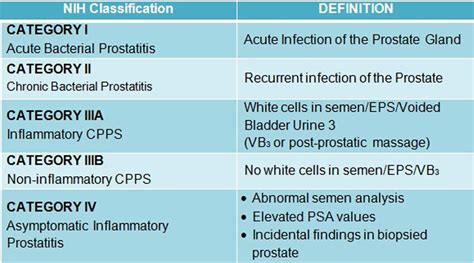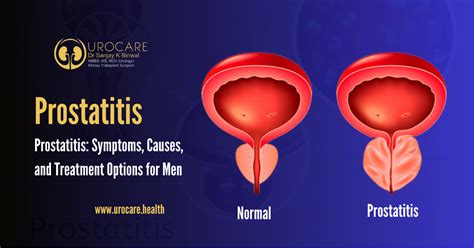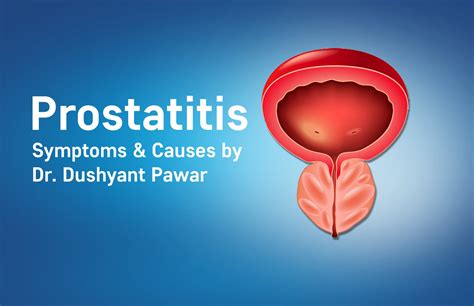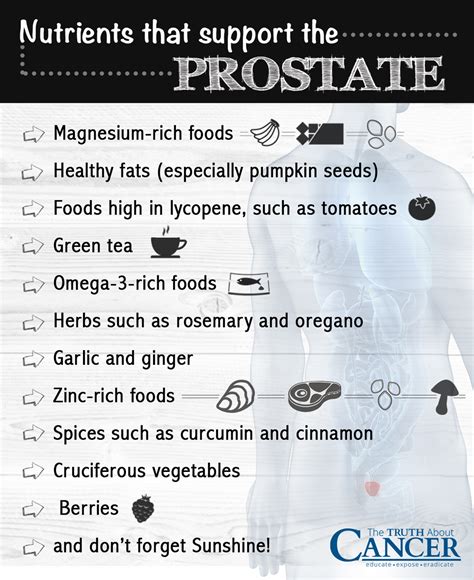Intro
Discover what is prostatitis, a common condition causing prostate inflammation, and learn about its symptoms, types, and treatments, including chronic prostatitis and acute prostatitis management.
Prostatitis is a medical condition that affects the prostate gland, a small, walnut-sized gland located below the bladder in men. The prostate gland plays a crucial role in the male reproductive system, producing fluids that make up semen and helping to regulate urine flow. Prostatitis occurs when the prostate gland becomes inflamed, leading to a range of symptoms that can be painful, uncomfortable, and disruptive to daily life. The condition is relatively common, affecting up to 10% of men at some point in their lives, and can occur in men of all ages, although it is more common in younger and middle-aged men.
Prostatitis can be caused by a variety of factors, including bacterial infections, viral infections, and other underlying medical conditions. In some cases, the cause of prostatitis may be unknown, and the condition may be referred to as chronic prostatitis or chronic pelvic pain syndrome. The symptoms of prostatitis can vary depending on the underlying cause and severity of the condition, but common symptoms include pain or discomfort in the pelvic area, painful urination, frequent urination, and difficulty starting or stopping urination. In severe cases, prostatitis can lead to more serious complications, such as infertility, prostate cancer, and chronic pain.
Understanding prostatitis is essential for men who are experiencing symptoms or have been diagnosed with the condition. By learning more about the causes, symptoms, and treatment options for prostatitis, men can take control of their health and work with their healthcare providers to develop an effective treatment plan. In this article, we will delve into the world of prostatitis, exploring the different types of prostatitis, the causes and symptoms of the condition, and the various treatment options available. Whether you are experiencing symptoms of prostatitis or are simply looking to learn more about the condition, this article aims to provide you with the information and resources you need to make informed decisions about your health.
Types of Prostatitis

Chronic bacterial prostatitis is a long-term infection of the prostate gland, also caused by bacteria. This type of prostatitis can be difficult to treat and may require prolonged courses of antibiotics. Chronic prostatitis/chronic pelvic pain syndrome is a type of prostatitis that is characterized by chronic pain in the pelvic area, often accompanied by symptoms such as urinary frequency and painful urination. The cause of this type of prostatitis is often unknown, and treatment may involve a combination of medications, lifestyle changes, and alternative therapies.
Asymptomatic inflammatory prostatitis is a type of prostatitis that is characterized by inflammation of the prostate gland, but does not produce any noticeable symptoms. This type of prostatitis is often discovered during a routine medical examination or while being tested for other conditions. Understanding the different types of prostatitis is essential for developing an effective treatment plan and managing symptoms.
Causes of Prostatitis

In some cases, the cause of prostatitis may be unknown, and the condition may be referred to as chronic prostatitis or chronic pelvic pain syndrome. This type of prostatitis is often characterized by chronic pain in the pelvic area, and may be accompanied by symptoms such as urinary frequency and painful urination. The exact cause of chronic prostatitis/chronic pelvic pain syndrome is not well understood, but it is thought to involve a combination of factors, including infection, inflammation, and muscle tension.
Risk Factors for Prostatitis
Several risk factors can increase the likelihood of developing prostatitis, including age, family history, and underlying medical conditions. Men who are younger than 50 are more likely to develop prostatitis, although the condition can occur in men of all ages. A family history of prostatitis or other prostate problems can also increase the risk of developing the condition. Underlying medical conditions, such as BPH and prostate cancer, can increase the risk of developing prostatitis, as can certain lifestyle factors, such as smoking and a sedentary lifestyle.Symptoms of Prostatitis

Diagnosing Prostatitis
Diagnosing prostatitis typically involves a combination of physical examination, medical history, and diagnostic tests. A physical examination may involve a digital rectal examination (DRE), which can help to identify any abnormalities in the prostate gland. A medical history can help to identify any underlying conditions or risk factors that may be contributing to the development of prostatitis. Diagnostic tests, such as urine tests and blood tests, can help to identify any underlying infections or inflammation.Treatment Options for Prostatitis

Alternative therapies, such as acupuncture and massage, may also be helpful in managing symptoms and improving quality of life. In some cases, surgery may be necessary to treat prostatitis, particularly if the condition is causing significant symptoms or complications. Surgery may involve removing any blockages or scar tissue that may be contributing to the development of prostatitis, or removing the prostate gland entirely.
Managing Symptoms of Prostatitis
Managing symptoms of prostatitis is essential for improving quality of life and reducing the risk of complications. This can involve a combination of medications, lifestyle changes, and alternative therapies. Practicing stress-reducing techniques, such as meditation and deep breathing, can help to manage symptoms such as pain and discomfort. Avoiding spicy or acidic foods, and avoiding caffeine and alcohol, can also help to manage symptoms.Getting regular exercise, such as walking or swimming, can help to improve overall health and reduce the risk of complications. Getting enough sleep, and practicing good sleep hygiene, can also help to manage symptoms and improve quality of life. Avoiding certain activities, such as cycling or horseback riding, can also help to manage symptoms and reduce the risk of complications.
Preventing Prostatitis

Practicing good hygiene, such as washing hands regularly and avoiding touching the face or eyes, can help to reduce the risk of infection. Avoiding certain activities, such as cycling or horseback riding, can also help to manage symptoms and reduce the risk of complications. Eating a healthy diet, rich in fruits, vegetables, and whole grains, can help to improve overall health and reduce the risk of complications.
Reducing the Risk of Complications
Reducing the risk of complications is essential for improving quality of life and managing symptoms of prostatitis. This can involve a combination of medications, lifestyle changes, and alternative therapies. Practicing stress-reducing techniques, such as meditation and deep breathing, can help to manage symptoms such as pain and discomfort. Avoiding spicy or acidic foods, and avoiding caffeine and alcohol, can also help to manage symptoms.Getting regular exercise, such as walking or swimming, can help to improve overall health and reduce the risk of complications. Getting enough sleep, and practicing good sleep hygiene, can also help to manage symptoms and improve quality of life. Avoiding certain activities, such as cycling or horseback riding, can also help to manage symptoms and reduce the risk of complications.
What is prostatitis?
+Prostatitis is a medical condition that affects the prostate gland, a small, walnut-sized gland located below the bladder in men. The condition occurs when the prostate gland becomes inflamed, leading to a range of symptoms that can be painful, uncomfortable, and disruptive to daily life.
What are the symptoms of prostatitis?
+The symptoms of prostatitis can vary depending on the type and severity of the condition. Common symptoms include pain or discomfort in the pelvic area, painful urination, frequent urination, and difficulty starting or stopping urination.
How is prostatitis diagnosed?
+Diagnosing prostatitis typically involves a combination of physical examination, medical history, and diagnostic tests. A physical examination may involve a digital rectal examination (DRE), which can help to identify any abnormalities in the prostate gland.
What are the treatment options for prostatitis?
+The treatment options for prostatitis depend on the type and severity of the condition. Antibiotics are often used to treat bacterial prostatitis, and may need to be taken for several weeks or months to ensure that the infection is fully cleared.
Can prostatitis be prevented?
+Preventing prostatitis is essential for reducing the risk of complications and improving quality of life. Practicing safe sex, such as using condoms, can help to reduce the risk of sexually transmitted infections (STIs) that can cause prostatitis.
